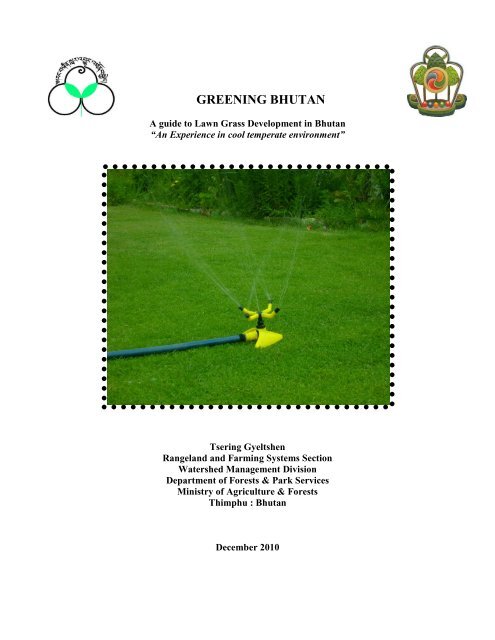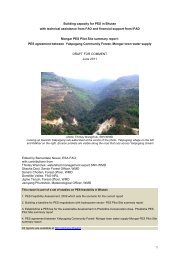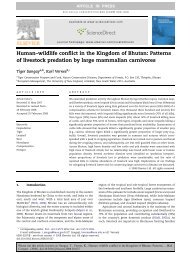A guide to Lawn Grass Development for temperate - DoFPS
A guide to Lawn Grass Development for temperate - DoFPS
A guide to Lawn Grass Development for temperate - DoFPS
Create successful ePaper yourself
Turn your PDF publications into a flip-book with our unique Google optimized e-Paper software.
GREENING BHUTAN<br />
A <strong>guide</strong> <strong>to</strong> <strong>Lawn</strong> <strong>Grass</strong> <strong>Development</strong> in Bhutan<br />
“An Experience in cool <strong>temperate</strong> environment”<br />
Tsering Gyeltshen<br />
Rangeland and Farming Systems Section<br />
Watershed Management Division<br />
Department of Forests & Park Services<br />
Ministry of Agriculture & Forests<br />
Thimphu : Bhutan<br />
December 2010
CONTENTS<br />
1. Background .................................................................................................................. 3<br />
2. Benefits ........................................................................................................................ 3<br />
3. New <strong>Lawn</strong> Establishment ............................................................................................ 4<br />
4. Planning ....................................................................................................................... 4<br />
5. Soil preparation............................................................................................................ 5<br />
6. Seed rate and sowing time ........................................................................................... 5<br />
7. Rake and roll ................................................................................................................ 6<br />
8. Watering ...................................................................................................................... 6<br />
9. Mowing and mower ..................................................................................................... 7<br />
10. Use of grass clippings .............................................................................................. 8<br />
11. <strong>Lawn</strong> maintenance ................................................................................................... 8<br />
11.1. Weeding ............................................................................................................ 8<br />
11.2. Top-dressing ..................................................................................................... 9<br />
11.3. <strong>Lawn</strong> Renovation .............................................................................................. 9<br />
12. Cool season grass ..................................................................................................... 9<br />
12.1. <strong>Lawn</strong> seed sources .......................................................................................... 10<br />
2
1. Background<br />
A <strong>guide</strong> <strong>to</strong> <strong>Lawn</strong> <strong>Grass</strong> <strong>Development</strong> in Bhutan<br />
“An Experience in cool <strong>temperate</strong> environment”<br />
The grasses we use <strong>to</strong>day <strong>for</strong> lawns have been around <strong>for</strong> centuries evolved in the<br />
meadows and <strong>for</strong>est glades grazed by large animals. The densely <strong>for</strong>med grasses that<br />
survived in these ecosystems are those that had low growing points and grazers did not<br />
eat them. A lawn is made up of thousands of individual grass plants or in mixtures of<br />
more than one grass species. Like any other plants, specific conditions must be met <strong>for</strong><br />
proper growth <strong>to</strong> occur <strong>to</strong> lawn grasses. When each plant is completely healthy, a lawn<br />
has the look of a “rolled-out carpet”.<br />
Pho<strong>to</strong> 1 & 2: Newly established lawn in front of Outlet centre, RDC, Yusipang.<br />
The first experience with the lawn grass development in Bhutan was in the early 80s<br />
when Royal Golf course in Thimphu was developed. Although the lawn grass<br />
development in general is a recent phenomenon, it is gaining popularity amongst the<br />
urban dwellers especially in the growing <strong>to</strong>wns such as Thimphu, Paro, Phuntsholing etc.<br />
2. Benefits<br />
<strong>Lawn</strong>s serve different purposes. A lawn is pleasant scenery <strong>for</strong> a home landscape that ties<br />
<strong>to</strong>gether the surrounding flower gardens, ornamental trees, and shrubs. Also a lawn is<br />
used as an outdoor living room during warm weather. Other advantages of lawn are that<br />
turf grasses controls dust and reduce pollen in the air from plants that can cause allergy<br />
problems <strong>to</strong> some individuals. Turf grasses absorb gaseous pollutants such as carbon<br />
dioxide converting them <strong>to</strong> oxygen (Imperial lawns, USA). <strong>Lawn</strong>s also benefit home<br />
landscapes in many environmental ways as well. When it is hot, a lawn reduces glare<br />
from the sun and keeps the surrounding area cooler. When it is windy, the blades of grass<br />
trap particles of dust and when it is rainy; a lawn stabilizes soil and prevents erosion<br />
problems.<br />
3
3. New <strong>Lawn</strong> Establishment<br />
Pho<strong>to</strong> 3: Perfect place <strong>for</strong> fun<br />
It is necessary <strong>to</strong> know the important steps of the lawn development techniques. The<br />
successful lawn establishment means doing the “right thing at the right time”.<br />
4. Planning<br />
Much success depends on how well you plan your lawn development. There should be<br />
provision <strong>for</strong> basic equipments and inputs (Table 1). A turf grass is available in two broad<br />
categories, warm season grasses and cool season grasses. Cool season grasses are<br />
recommended <strong>for</strong> warm <strong>temperate</strong> <strong>to</strong> sub alpine zones
5. Soil preparation<br />
Preparing a field <strong>for</strong> lawn development is one of the most vital steps and a good seedbed<br />
preparation is a prerequisite <strong>for</strong> successful lawn establishment. If the soil is poor, arrange<br />
additional <strong>for</strong>est <strong>to</strong>psoil. The <strong>to</strong>psoil from broadleaved <strong>for</strong>est is preferred. Topsoil from<br />
the blue pine dominated <strong>for</strong>est can be used but it has acidity problem. On removing<br />
debris such as s<strong>to</strong>nes, wood and other items from the planting area, add the <strong>to</strong>p soil and<br />
the thickness of <strong>to</strong>psoil should be uni<strong>for</strong>m both on slope and flat areas.<br />
It is advisable <strong>to</strong> test your soil be<strong>for</strong>e adding any nutrient <strong>to</strong> the soil. A soil test eliminates<br />
guessing the amount of nutrients <strong>to</strong> be added. <strong>Lawn</strong> grass species per<strong>for</strong>m well at soil pH<br />
range of 5.5 <strong>to</strong> 7. For the proper grass growth, if your soil pH is below 5.5 add lime <strong>to</strong> the<br />
soil and if it is above 7, add sulfur. Organic matter and other soil additives such as<br />
fertilizers can usually be mixed with the <strong>to</strong>psoil. <strong>Lawn</strong> requires a larger amount of<br />
inorganic fertilizers mainly Nitrogen, Phosphorus and Potassium (NPK). <strong>Lawn</strong>s require a<br />
large amount of N-Nitrogen <strong>to</strong> promote growth, color and general vigor. P-Phosphorus<br />
stimulates early root growth <strong>to</strong> ensure seedlings develop properly. Freshly seeded lawns<br />
require a fertilizer with high phosphorus content. Also P is necessary <strong>for</strong> proper plant cell<br />
division, which results in a strong, healthy and sturdy grass plant. K-Potassium<br />
strengthens root structure and increases disease resistance, improving the overall<br />
hardiness of grass plants. Even distribution of these materials of soil is most important.<br />
Rake the surface and roll the soil with a heavy roller 90-130 kg <strong>to</strong> define humps and<br />
hollows. Then rake surface lightly even off these irregularities and <strong>to</strong> prepare a loose<br />
planting bed of 1/4 -1/2 inch of soil.<br />
Pho<strong>to</strong>es 4, 5, & 6: Different stages of land preparation <strong>for</strong> lawn establishment<br />
6. Seed rate and sowing time<br />
Seed rate while sowing depends on what lawn species one chooses and size of seeds. For<br />
instance Tall fescue (Festuca arundinacea) is 130kg per acre and whereas Kentucky<br />
bluegrass (Poa pratensis) seed rate is 35-40 kg/acre is applied. <strong>Lawn</strong> can also be sown in<br />
mixtures of 2-3 grass types. When a mixture containing seed two or more types of is<br />
applied, it has an advantage-the strength of one grass type compensates <strong>for</strong> the weakness<br />
of another. For this reason, a mixture is best <strong>for</strong> the average lawn. Broadcast the seed by<br />
hand. In order <strong>to</strong> ensure uni<strong>for</strong>mity distribution of seeds over a bed, use half the seeds<br />
first and sow remaining half in a crosswise direction. It is important <strong>to</strong> remember the best<br />
sowing time is when air is calm.<br />
5
The best time <strong>to</strong> sow lawn seeds is in early spring (late March - early May) under<br />
irrigation in the cool <strong>temperate</strong> environment. <strong>Lawn</strong> can also be sown in summer but the<br />
heavy rain shower can affects the germination and establishment. The alternative sowing<br />
time is <strong>to</strong>wards the end of rainy season i.e.; mid September <strong>to</strong> end September when the<br />
optimal temperature <strong>for</strong> plant growth still adequate and young plants can survive over<br />
winter. Try <strong>to</strong> avoid seeding lawn during peak monsoon as lawn establishment is badly<br />
affected due <strong>to</strong> dominance by seasonal weeds that makes difficult <strong>to</strong> control. It also<br />
makes difficult <strong>to</strong> prepare land <strong>for</strong> seeding due <strong>to</strong> excess soil moisture. In most cases, the<br />
seeds are washed away and mini gullies are <strong>for</strong>med and eventually end up with heavy<br />
cost of reseedings – seed, fertilizer and labor. Under such situations mulching can be one<br />
of the control measures but it may not be practical if the lawn area is huge.<br />
It is important <strong>to</strong> treat your newly seeded lawn with special care. While it is getting<br />
established itself, surround the lawn area with stakes and stretched string <strong>to</strong> prevent<br />
people and animals from entering the area. Temporary fencing using bamboo materials<br />
can also serve the purpose.<br />
7. Rake and roll<br />
Once the seed is sown, lightly rake the seed in<strong>to</strong> soil, no deeper than the recommended<br />
planting depth <strong>for</strong> the particular variety. A thumb rule is that the depth should be just<br />
double of the seed size. While raking, care must be taken that the teeth just <strong>to</strong>uch the soil<br />
surface. Too much pressure will cover the seeds <strong>to</strong>o deep or move away some of them<br />
and leave bare spots in the new lawn. Make sure the seed is covered carefully until about<br />
10% is still visible. Finally roll the area with a light roller (25-35 kg) <strong>to</strong> compact the soil.<br />
If roller is not available, wooden blocks can also be used and ramming should be done<br />
from one direction.<br />
Pho<strong>to</strong> 7 & 8: Wooden blocks and roller used <strong>to</strong> roll the area after seeding <strong>to</strong> firm the soil.<br />
8. Watering<br />
Irrigate the lawn soon after the seeding is completed. Frequent light watering promotes<br />
seed germination and rapid establishment. It is important <strong>to</strong> keep in mind that the seed<br />
bed is kept not dry or become soaked. Under ideal conditions, lawn seed germinates<br />
within 10 -15 days period. Germination rates vary according <strong>to</strong> the seed type and weather<br />
conditions. For light sprinkling, hand watering usually gives better regulations than a<br />
6
sprinkler. New seedlings require light and frequent watering (2 times per day <strong>for</strong> the first<br />
2 weeks). As grass begins <strong>to</strong> grow, decrease the watering frequency but increase the<br />
amount of water used each time.<br />
Early morning is the ideal time <strong>to</strong> water and morning watering has advantage of less<br />
wind, milder temperatures, and adequate water pressure. Watering in the early hours is<br />
also best time <strong>to</strong> avoid possible spread of disease and fungus. It is important <strong>to</strong> note that<br />
cool season grasses require more water as compared <strong>to</strong> warm season grasses. When the<br />
lawn enters dormant periods in winter, watering at an interval of 2 weeks are essential <strong>to</strong><br />
keep the crowns of the grass alive. Afternoon watering has several disadvantages as<br />
evaporation caused by the wind and sun is at maximum, and there<strong>for</strong>e only lesser amount<br />
of water applied actually reaches the lawn. The best advice, though, <strong>for</strong> when <strong>to</strong> water is:<br />
“Water when the lawn needs it”.<br />
Pho<strong>to</strong> 9: Manual watering Pho<strong>to</strong> 10: Watering Poa pratensis lawn using sprinkler<br />
9. Mowing and mower<br />
Theory says; “mow a new lawn <strong>for</strong> the first time after it has grown a third higher than the<br />
regular mowing height.” For example, a lawn that should be maintained at a height of 2<br />
inches or 2 inches high, it should be mowed when it reaches 2.5 <strong>to</strong> 3 inches. Do not<br />
remove more than a third of the <strong>to</strong>tal height of the grass. However, in field conditions,<br />
this is not practical as the soil remains <strong>to</strong>o soft and new grass is <strong>to</strong>o loosely knit <strong>to</strong> mow<br />
without damage. The best way is <strong>to</strong> wait and let lawn continue <strong>to</strong> grow taller than<br />
recommended height <strong>for</strong> newly established lawn.<br />
<strong>Grass</strong>es such as Kentucky bluegrass and Tall fescue cannot be mowed <strong>to</strong>o low (below 1.5<br />
- 2 inches) because they do not have enough leaf surfaces <strong>to</strong> support the plants. The<br />
recommended mowing height <strong>for</strong> Kentucky blue grass and perennial ryegrass should be<br />
at the height of 2”- 3”and tall fescue 2.5” - 3.5” from the ground level. Always remember<br />
<strong>to</strong> keep your mower blade sharp <strong>to</strong> avoid injury <strong>to</strong> young plants or damage <strong>to</strong> the turf<br />
grass. At a 2-inch mowing height the grass needs mowing be<strong>for</strong>e it reaches 3 inches that<br />
is well established lawn. Weekly mowing is usually enough <strong>to</strong> maintain the 2-inch<br />
mowing height during growing season. Do not let lawn grasses become over grown<br />
be<strong>for</strong>e mowing and always follow recommended mowing height & frequency of mowing.<br />
7
Prior <strong>to</strong> mowing always make a point <strong>to</strong> walk over the lawn area and check if there are<br />
s<strong>to</strong>nes, wires and other debris that could be hazard <strong>to</strong> opera<strong>to</strong>r and mower machine.<br />
Remember always that “Timely mowing is necessary <strong>for</strong> quality turf-grass and rule of<br />
thumb is <strong>to</strong> mow enough that you never remove more than one-third of the leaf area per<br />
mowing”<br />
The type of mower depends on the size of the lawn being planned. For a smaller lawn<br />
area, simple mowers such as push reel mower should work. However <strong>for</strong> the medium and<br />
larger area of lawn grass, power rotary mower and riding mower with powerful engine is<br />
ideal. An important aspect while buying a lawn mower is simplicity of its operation.<br />
Pho<strong>to</strong>es 11, 12 & 13: Simple push reel mower used <strong>for</strong> mowing small area lawn<br />
10. Use of grass clippings<br />
<strong>Grass</strong> clippings are <strong>to</strong>o valuable <strong>to</strong> waste. Literature review says they contain 4%<br />
nitrogen (N), 0.5% phosphorus (P), 2% potassium (K) and small amounts of other plant<br />
nutrients. The best way <strong>to</strong> handle grass clippings is <strong>to</strong> leave them on the lawn as it<br />
eventually decomposes & recycles nutrients back in<strong>to</strong> the soil. This is recommended<br />
under proper mowing conditions and with the proper mowing, clippings will be short<br />
enough and quickly decompose within the lawn area. However if the grass is <strong>to</strong>o long,<br />
the grass clipping can clump and damage lawn. Under such situation, grass clippings can<br />
be used <strong>for</strong> making compost. It is also important <strong>to</strong> remember that if lawn is diseased<br />
removing grass clipping from lawn area help reduce the level of disease.<br />
11. <strong>Lawn</strong> maintenance<br />
11.1. Weeding<br />
As it is not possible <strong>to</strong> treat or sterilize soil and the local weeds dominate the lawn<br />
grasses during the first establishment year. Manual weeding is there<strong>for</strong>e recommended<br />
during the first year. Usually by the following year, weed is not a major problem.<br />
However presence of White clover (Trifolium repens) plants in the lawn has <strong>to</strong> be<br />
checked. This fodder legume is very aggressive and can spread through its s<strong>to</strong>lons and<br />
seeds, and can dominate whole lawn area in a season time if the whole plant is not<br />
uprooted at the seedling stage.<br />
8
Pho<strong>to</strong>es 14& 15: Young white clover (Trifolium repens) plant & <strong>Lawn</strong> grass dominated by T. repens<br />
11.2. Top-dressing<br />
It is important <strong>to</strong> <strong>to</strong>p dress with light dose of N fertilizer in the <strong>for</strong>m of Urea after every<br />
mowing. The recommended dose of urea is 20-30kg per acre. However, excessive<br />
application of soluble nitrogen <strong>to</strong> the lawn, without any irrigation facilities will damage<br />
the lawn (burn). Always apply inorganic fertilizer N when lawn is wet that is after<br />
irrigation or rain.<br />
11.3. <strong>Lawn</strong> Renovation<br />
<strong>Lawn</strong>s need <strong>to</strong> be renovated periodically <strong>to</strong> encourage vigorous growth. If your lawn is<br />
basically healthy with some bare spots, some minor renovating can make it look like new.<br />
This can be achieved by reseeding or patching it with a piece of sod that is cut <strong>to</strong> fit the<br />
affected area.<br />
12. Cool season grass<br />
There are many cool season grass species that can be used as lawn. Kentucky bluegrass<br />
alone has more than 100 varieties available in the world market and similarly other grass<br />
species also have many varieties. However in Bhutan, only a few particular cool season<br />
grass species were tested and the grass species that per<strong>for</strong>ms well under cool <strong>temperate</strong><br />
environments are presented in Table 2.<br />
Table 2: Cool season grass tested in Bhutan<br />
Common Name Scientific Name Varieties<br />
I. Cool season grasses<br />
Kentucky bluegrass Poa pratensis Broadway, Cocktail, Miracle,<br />
Side kick, Compact<br />
Perennial ryegrass Lolium perenne Jessica, Henrietta & Merci<br />
Tall fescue<br />
Festuca arundinaecea Demeter<br />
Red fescue<br />
Festuca rubra<br />
Creeping bent grass (<strong>for</strong> Agrostis palustris<br />
golf course)<br />
II. Warm season grasses<br />
Carpet grass<br />
Axonopus affinis<br />
9
Pho<strong>to</strong>es 16 & 17: Pure stand lawn of Poa pratensis, varieties Broadway & Compact.<br />
Pho<strong>to</strong> 18: Pure lawn of Festuca arundinacea<br />
Pho<strong>to</strong> 19:<strong>Lawn</strong> of P.pratensis & L. perenne mixture<br />
12.1. <strong>Lawn</strong> seed sources<br />
Tall fescue and Red fescue can be obtained from the National Feed & Fodder<br />
<strong>Development</strong> Program, Department of Lives<strong>to</strong>ck, Bumthang on demand. Other grass<br />
species are not available in Bhutan at the moment and has <strong>to</strong> be imported. Seed<br />
production of some lawn grass species are under observations at RDC Yusipang and<br />
intermediate results of seed production is presented in Table 3:<br />
Table 3: <strong>Lawn</strong> grass seed production at DRC, Yusipang<br />
Common name Scientific name Variety Seed yield kg/ha<br />
Kentucky bluegrass Poa pratensis 452.5<br />
Perennial ryegrass Lolium perenne Flanker 500.0<br />
-do- -do- Meridian 262.5<br />
-do- -do- Matilda 500.0<br />
-do- -do- Mariner 400.0<br />
Source: Lives<strong>to</strong>ck Sec<strong>to</strong>r, RDC,Yusipang<br />
10
Pho<strong>to</strong>es 20, 21 & 22: Pao pratensis and Lolium perenne & Poa pratensis seed production plot at RDC,<br />
Yusipang<br />
For any technical query or clarifications on the lawn grass development, contact can be<br />
made <strong>to</strong> either of the following addresses:<br />
1. Rangeland and Farming Systems Section<br />
Watershed Management Division<br />
Department of Forests and Park Services<br />
Thimphu<br />
Tel: 323568/323539<br />
2. Lives<strong>to</strong>ck Sec<strong>to</strong>r<br />
RNR Research & <strong>Development</strong> Centre,<br />
Department of Forests and Park Services,<br />
Yusipang.<br />
Tel: 771 91124<br />
11





